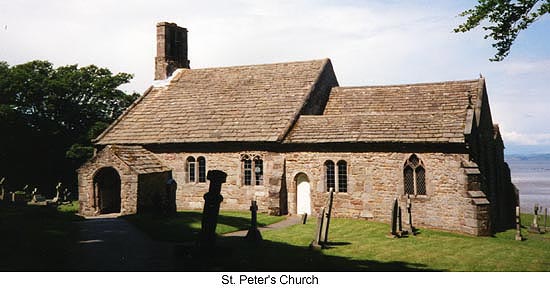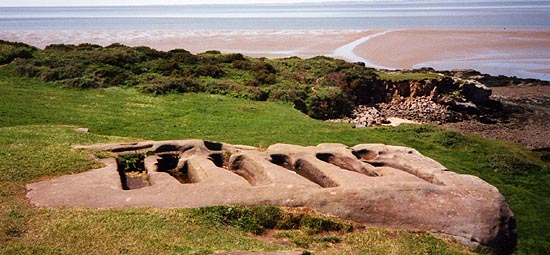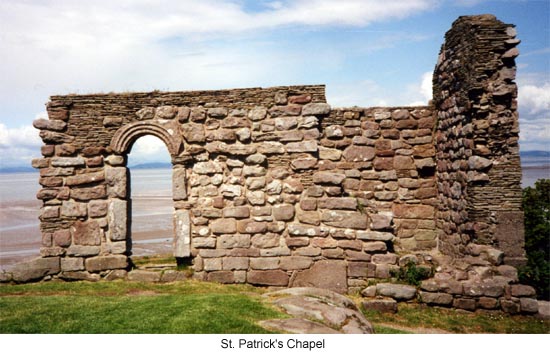The Rock-Hewn Graves of Heysham
by Elizabeth Ashworth
They don't sell nettle beer on Main Street in Heysham any more, but you can still sit on the Brass Beam Scale and get weighed in public, if you're brave enough. There's a Heritage Centre now in what was once a barn for the 17th century farmhouse next door; an antique shop has opened beyond the pub, but the ancient bric-a-brac shop, selling second hand books and home-made peg bags has merchandise in its window that I'm sure I remember seeing there when I visited as a child. Apart from the fact that the car park's become pay and display and there are bins for re-cycling your rubbish, not much changes in this quaint little village on the southern coast of Morecambe Bay. That's its charm.

Most visitors make their way up Main Street, past St Patrick's Well and into St Peter's churchyard. The small, squat church is one of the oldest in Lancashire, dating from around the Norman Conquest in 1066. Inside, some of the pews are by windows that look out over the Bay; you could probably draw more divine inspiration from that view than a dozen boring sermons -- and probably many worshippers have over the years, watching the oystercatchers, curlew and redshank wading on the shoreline
Outside a stroll around the gravestones is fascinating if only to count the number of deaths by drowning -- the picturesque Bay has long been a fertile gathering ground for cockles and mussels and it's always been keen to claim its victims.

And it's graves that people are interested in as they climb the narrow stone steps to the clifftop where the ruin of St Patrick's chapel dominates the windy headland. Just below are the rock hewn graves -- empty now, or filled with water on rainy days. A base for a cross or headstone is cut by some and they're thought to be amongst the earliest examples of Christian burial in the country. Nobody knows who was buried in them, though some say they were for the privileged only, seeing that more than 90 other burials were found during an archaeological excavation in the early 1970s. They're very small, I notice, one especially could have been for a child. I wonder who those people were who wanted to spend eternity gazing out towards the Lake District hills.
Legend has it that St Patrick was shipwrecked here, but was lucky enough to stumble ashore and that he built this chapel as a thanksgiving sometime in the 6th century. It's seems more likely though that it was built later, even around the same time as the church, and may have been a small monastery, possibly constructed to honour the remains of the inhabitants of the graves.

Head back down into the village, past the small cottages and you can make your way onto the coastal path that leads to Morecambe, though perhaps you may prefer to pause and eat Italian ice-cream from the little green kiosk first.
From here you can watch today's cocklers being driven, on quad bikes, out onto the sandbanks at low tide to rake in their marine harvest. It's back-breaking, dangerous work for small reward -- and rather than being sold in Lancashire seaside towns this harvest is now mainly sold abroad to Spain and Holland.
Today Heysham is probably best known for its nuclear power plants. As you approach the village from Lancaster you can see the forests of pylons and hear the buzz of electricity being carried away to fuel our 21st century lives.
The harbour too still thrives. It's part of one of the main cargo routes to Ireland and a passenger ferry sails regularly from here to the Isle of Man.
At Heysham you'll find the old and the new within a stone's throw of each other, reminding us that people will stand to draw inspiration here when we're all long gone. Maybe they'll wonder about the lives we live now. Hopefully they'll pause to reflect on their ever lengthening past and if we're lucky some of them may remember us.
More Information:
We regret that we no longer have the resources to maintain up-to-date links and/or hours and pricing details for the various sites and attractions listed on this website. For more information about the location(s) listed above, please use your favorite search engine or visit Wikipedia.
Elizabeth Ashworth writes fiction and nonfiction for both adults and children. Her short stories have appeared in such publications as Christian Herald, People's Friend, Take a Break Fiction Feast, My Weekly and Parentcare; her nonfiction has appeared in a variety of magazines, including The Lady, Lancashire Life and My Weekly. She is also a regular contributor to Lancashire Magazine. Her books include Champion Lancastrians (Sigma Press, 2006) and Tales of Old Lancashire (Countryside Books, 2007); she is currently working on a book on Lancashire Graves, and a novel titled "The De Lacy Inheritance."
Article and photos © 2005 Elizabeth Ashworth
| 